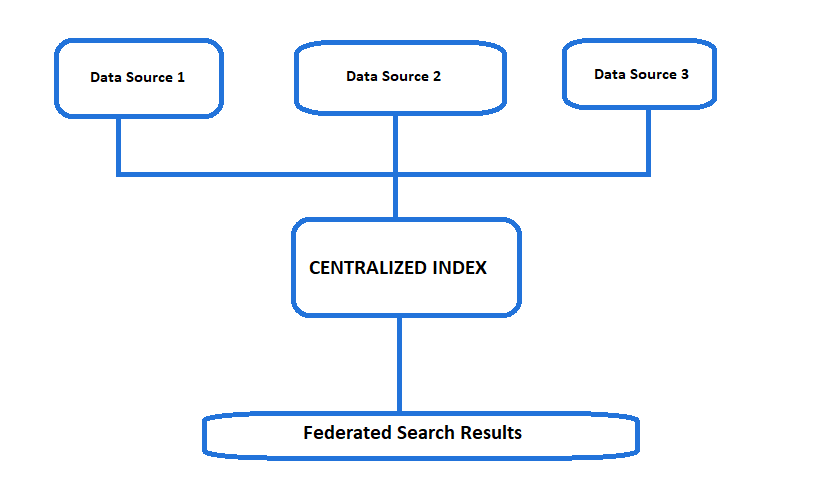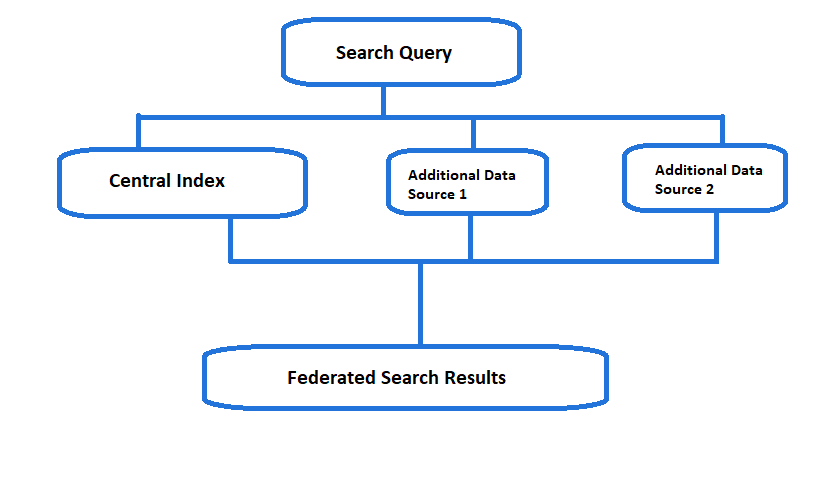
Onsite search is an important functionality for eCommerce stores. Around 43% of retail customers admitted that they directly head to the search bar on a website to find the products. Another study revealed that 78% of customers run into products not relevant to what they are looking for. These statistics highlight that the quality of search functionality impacts customers and their experience with your brand. It is one of the most important elements of any online store.
Federated search is one search technique that ensures your customers can easily find what they are looking for without any difficulties. It offers a reliable search function to build seamless shopping experiences for customers.
In this post, we will learn more about federated search, how it works, and its applications in eCommerce.
What Is Federated Search?
Federated search is a search technique that supports the querying of data from multiple data sources. Instead of searching for products in each source separately, federated search aggregates results from different product categories or content types and displays them in a unified search results page. It aims to deliver a seamless and comprehensive onsite search experience by allowing site visitors to search through all your content using a single search bar.

Let us consider a bookstore website selling paperback books, hardcover books, eBooks, and audiobooks. This website has implemented federated search to simplify search functionality. In this case, federated search will allow customers to search for 'Harry Potter' and instantly show results from all these categories without requiring the customers to individually browse through separate sections.
Importance of Federated Search
Federated search delivers highly relevant and accurate search results by gathering results from diverse data sources. This not only simplifies website navigation but also boosts customer engagement. Here are a few ways how federated search enhances your store's functionality.
Improved Search Results' Relevance
Federated search delivers relevant results by aggregating data from multiple sources. It ranks these results based on the context of the queries, thus eliminating irrelevant results and offering a tailored shopping experience to the customers.
Enhanced Customer Engagement
Federated search shares comprehensive search results, offering a mix of product suggestions, content suggestions, FAQs, multimedia assets, documentation, and more. Thus, customers can quickly find what they are looking for. This keeps them engaged on your website for longer durations, exploring more products and increasing their likelihood of purchases.
Better Shopping Experiences
Federated search allows customers to discover products, product categories, blog posts, and other recommendations from different data sources in one search operation. This reduces buyer frustration and creates smooth shopping experiences for customers.
Streamlined Website Expansion
Federated search is designed to accommodate additional data repositories effortlessly. So, if you are introducing additional product catalogs to expand your business, you do not have to spend additional time and effort to integrate new data sources. This ensures easy website scalability without disrupting customer experiences.
How Does Federated Search Work?
The federated search follows a simple six-step process.
Step #1 - Customer inputs the query (Query Input) - A customer submits a query in the federated search bar. In this step, the query is captured by the search and is distributed to various connected data sources.
Step #2 - Query is translated for search (Query Parsing and Optimization) - The federated search system translates the customer's query into formats compatible with each data source. This ensures proper communication with databases, APIs, or proprietary systems.
Step #3 - Search system communicates with data sources (Source Selection) - The system sends the translated query to multiple sources (e.g., content management systems, cloud storage, and enterprise databases) simultaneously to find relevant resource descriptions.
Step #4 - Results are retrieved (Query Execution) - Each source processes the query independently and returns results. These results may include metadata such as relevance scores, document summaries, or file formats.
Step #5 - Aggregation and ranking (Result Conciliation) - The federated search engine consolidates results from all sources, removing duplicates and ensuring relevance. Advanced AI algorithms work on assigning relevance scores across sources to present a unified ranking.
Step #6 - Merging and presenting the results (Answer Sharing) - The search results are displayed in a single interface. Customers can see integrated results on their search results page for further exploration.

That being said, let us understand the different types of federated searches that you can implement on your online store.
3 Types of Federated Searches
There are majorly three types of federated searches based on how the search engine merges and presents data from various sources.
1. Search Time Merging
Search time merging involves sending the customer's query to multiple data sources simultaneously in order to find relevant results. Each data source then processes the query independently to generate results. These results are then combined into a unified list by the search system and ranked before presenting to the customers. This approach is also known as query time merging.

One advantage of using this type of federation search is that it is simpler to implement. You do not have to consolidate all your data sources into a single, centralized source. As it can search individual data sources separately, it can handle different formats of data at a time. Thus, eliminating the requirement for data standardization altogether.
However, it does come with its fair share of drawbacks. It is often observed that the response time of this type of federated search is slower. This is because every data source needs to be queried in order for the final results to be presented. Further, it can lead to inconsistent ranking as metrics differ for each data source.
2. Index Time Merging
Index time merging involves creating a centralized index of data from multiple sources that is used by the search system to retrieve results during a search operation. This pre-processed index of information serves as a unified repository for faster and more consistent querying. So, when a customer starts a search, the search system refers to this unified index to find the relevant searchable data.

To implement this type of federated search, you need to extract data from various content sources and convert them into a standardized format. This is to ensure consistency in structure, format, and terminology in the centralized index. This standardized data is then stored in a central index for easy retrieval.
One of the biggest advantages of index time merging is that the search results are presented much faster as the search system no longer depends on individual data sources to respond. Further, the centralized index allows the use of advanced relevancy algorithms to rank the search results based on relevancy. However, it does require a significant amount of effort and time for setup. This can certainly cause delays in the implementation process. Moreover, the costs of maintaining a centralized index can be high as your business scales.
3. Hybrid Federated Search
Hybrid federated search offers the advantages of both, search time merging and index time merging. It creates a centralized index for the majority of data while querying additional sources in real-time to address specific needs.
This type of federated search approach leverages intelligent routing algorithms to decide whether the search system must access the central index, additional sources, or both, depending on the type of search operation. For this, the core data or frequently accessed data is stored in a central index. The search system also queries additional databases i.e. the ones that are not integrated into the index. The results are then combined and presented to the customers as a single list.

Hybrid federated search works best when you are dealing with a mix of static and dynamic content sources. It offers optimized performance as it can accommodate a wide range of data sources without burdening the central index, lowering the implementation and maintenance costs. However, its implementation is a tricky process as it requires careful planning to determine which data to include in the central index and which to reside in additional external databases.
Use Cases of Federated Search in ECommerce
Federated search offers faster and more efficient search functionalities that enhance customer experiences and promote additional sales. Here are the key use cases of federated search in eCommerce.
1. Provides a Unified Search Across Categories
Federated search allows customers to search across various product categories simultaneously and deliver comprehensive results in one query. Instead of sifting through different product sections of an eCommerce website, customers can view products from all relevant categories, such as electronics, clothing, and accessories, at the same time.
This streamlined search process boosts customer convenience by saving time and enhancing the shopping experience. Customers can compare options easily and make quicker purchasing decisions, leading to increased conversions.
For example, Amazon implements federated search to offer its customers with unified search experience across its various product categories. Suppose a customer searches for 'birthday balloons', the search results display not only birthday balloons but also other kinds of balloons, related accessories, and even reviews. Customers can find everything they need in a single search rather than navigating through separate product categories.

2. Improves Search Across Content Types
Federated search not only aggregates product results but also integrates other content types like reviews, videos, blog articles, and FAQs. This allows customers to find not just the products they are searching for but also helpful supporting content that can inform their buying decisions.
This approach makes shopping more interactive and educational. Customers are empowered with all the relevant information in one place, reducing the need to navigate away from the search results to find additional content like how-to guides or customer reviews. It also improves customer engagement and satisfaction.
For example, Heavyglare Eyewear employs federated search across its vast product range. A search for 'contact lenses' might display options from eyeglasses, sunglasses, and even blog post suggestions on a single result page. This ability to merge search results across different categories provides a seamless experience for customers.

3. Offers Multi-Store or Marketplace Search
In marketplaces or multi-store websites, federated search helps integrate product listings from different sellers into a unified search result. This is especially useful in eCommerce platforms with multiple merchants, as it allows customers to see products from different stores in a single search result.
This functionality enhances competition among sellers and allows customers to make better purchasing decisions by comparing products based on features, prices, and customer ratings. It also increases visibility for smaller sellers who would otherwise be lost in a vast catalog.
For example, Etsy uses federated search for its marketplace. When searching for a product like “handmade jewelry,” customers are presented with options from various independent sellers, allowing them to compare unique items in one unified view.

4. Facilitates Better Backend Efficiency
Federated search enables backend systems to pull data from multiple sources without overloading servers or increasing the complexity of data storage. This helps eCommerce sites stay efficient and ensures that search operations run smoothly, even with large inventories or when dealing with vast amounts of user data.
By automating data aggregation and simplifying search functions, federated search boosts system performance. It reduces the strain on servers and improves site speed, which is crucial for maintaining a seamless user experience.
For instance, Walmart’s use of federated search ensures that millions of product listings, from various suppliers and categories, are indexed efficiently. This system enables fast and responsive searches even during peak shopping times, improving site reliability and reducing lag.

5. Minimizes Security Risks Associated with Multiple Search Engines
Federated search centralizes search operations, which mitigates the need to rely on multiple external search engines or third-party services. This reduces the potential security vulnerabilities that can arise from using multiple, disjointed search systems.
By consolidating data into a single search framework, federated search minimizes security risks, such as unauthorized data access or breaches caused by inconsistent security practices. This makes it easier for businesses to maintain compliance with data protection standards.
For example, Ramesh Watch Co. uses federated search to reduce its reliance on external search engines and consolidates all product, review, and content data in one secure search interface. This helps ensure that all transactions and data exchanges are handled safely under their internal security protocols.

Implementing Federated Search Engine with Sparq
Federated search is a powerful solution to enhance the search functionality of your eCommerce stores. It aggregates results from multiple data sources into a single, seamless search experience. It is proven to improve customer experience, increase conversions, and streamline backend operations.
However, implementing such a solution can be complex and challenging. Hence, it is important to select the right tool to ensure it integrates smoothly with your existing systems. This is where Sparq comes in.
Sparq offers an advanced product search solution that leverages federated search to provide customers with relevant and personalized results. It works seamlessly across different product categories, content types, and even multiple stores or marketplaces. With Sparq, you can transform your site’s search functionality to make it faster and smarter. Thus, improving overall engagement and customer satisfaction.
- A unified search experience allows customers to find products, content, and recommendations in one place, improving the user experience.
- Real-time results as it can index data across various sources in real-time. Thus, ensuring that customers always see the most up-to-date results.
- AI-powered search to deliver highly accurate and personalized search results based on user behavior, preferences, and search patterns.
By implementing Sparq’s federated search engine, you can unlock the full potential of your eCommerce search. Ready to enhance your site’s search capabilities? Schedule a demo today and see how federated search can transform your business.
FAQs
What is an example of federated search?
The best example of federated search would be the eCommerce giant, Amazon. Amazon uses federated search to allow customers to search for products across different product categories like electronics, clothing, books, and more using a single search bar.
What are the pros and cons of federated search?
Federated search shares unified results from multiple data sources, thereby saving customers time in navigating through diverse product categories and large inventories. It supports tailored ranking algorithms to ensure better search results relevance. The cons include a complex implementation process, slow response times, and higher costs.
How does AI improve federated search?
AI improves federated search by -
- Leveraging natural language processing to understand customer intent. This is especially true when queries are complex or ambiguous.
- Using machine learning to rank search results based on customer behavior and preferences.
- Offering dynamic search suggestions to refine queries and simplify search process.
